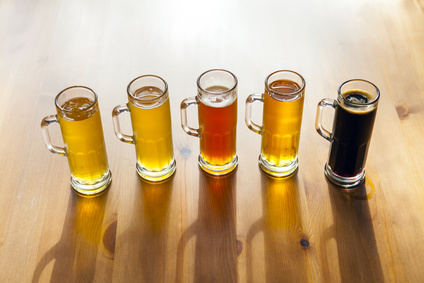Navigating beer in Germany as a foreigner can be daunting. There are over four dozen official varieties, each stemming from the various regions of Germany and owing to specialized brewing techniques. Here we will look at the basics as well as some cultural tips surrounding beer consumption.
First off, beer in Germany is considered a food item. It is widely available in grocery stores, all restaurants and pubs, concession stands and even vending machines. Age limitations on alcohol consumption are much lower than those found in North America. Teenagers aged 14 or older may consume beer or wine in restaurants when an adult is present. At the age of 16, youth may drink beer or wine unaccompanied. To consume hard liquor, the age limit is set at 18. Similar laws apply to the purchase of alcohol. Special beverages comprised of beer and soft drinks are also available for younger drinkers, to lower the alcohol percentage. As there are no strict age restrictions or separate “pubs/bars,” family members of all ages may dine together at all times allowing for a more multigenerational social life.
As beer is considered a food item, it’s pricing is more in line with that of soft drinks and mineral waters; between two and four euros depending on the size. Beer is often taken with lunch as well although this practice is declining. Beer consumption in Germany overall has been declining for the last two decades owing to the aging population, healthier trends as well as young people experimenting with new foreign alcoholic drinks. That said, Germany still ranks fifth in the world in beer consumption with 110 L per person per year.
The German government strictly controls beer production going back to the 16th century. It may only be made with four ingredients: water, hops, yeast and malt. All variances are based on the technique in brewing. The type of beer you will be ordering in a given restaurant owes a lot to the region in which you find yourself. Every region produces its own traditional beer type. Here are some of the more common ones:
Pils-the most popular with roughly 60% of the market share
Kölsch-specific to the Cologne region
Altbier-an ale specific to Düsseldorf and region
Weissbier-most popular in Bavaria
Hefeweizen– cloudy in appearance due to yeast being left in, wheat malt
Bockbier-based on a barley malt, high alcohol content and brewed for holiday occasions
Helles-a lager, light in color and easy to drink
Dunkles-Amber to dark in color, more of a sipping beer
The label on the beer bottle will give you much information such as, the name and type of beer, the brewery’s location, the year the company was founded, and of course its alcohol content. Most German beers are between 3.5% and 6% alcohol content. Low alcohol or nonalcoholic beers are also popular. Nonalcoholic beers generally taste much better than their North American equivalents.
When out drinking with Germans, the most common way to say cheers is Prost. This may be called out by someone for every new round of beer or at any time. The tradition is to lift up your beer glass, sometimes even above your head, and call out Prost before lowering it to take a drink. Another common way to say cheers is Zum Wohl which roughly translates as “to your health.”








